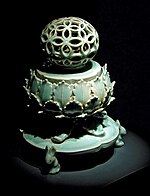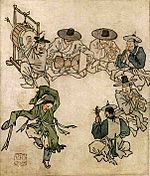National Museum of Korea
Template:Infobox Korean Museum
The National Museum of Korea is the flagship museum of Korean history and art in South Korea and is the cultural organization that represents Korea. Since its establishment in 1945, the museum has been committed to various studies and research activities in the fields of archaeology, history, and art, continuously developing a variety of exhibitions and education programs.
In October 2005, the museum opened in a new building in Yongsan Family Park in Seoul, South Korea. The museum contains over 220,000 pieces in its collection with about 13,000 pieces on display at one time. It displays relics and artifacts throughout six permanent exhibition galleries such as Archaeological Gallery, Historical Gallery, Fine Arts Gallery I, Donation Gallery, Fine Arts Gallery II, and Asian Art Gallery. It is the sixth largest museum in the world in terms of floor space, now covering a total of 137,201 square metres (1,480,000 sq ft).[1]
In order to protect the artefacts inside the museum, the main building was built to withstand a magnitude 6.0 Richter Scale earthquake. The display cases are equipped with shock-absorbent platforms. There is also an imported natural lighting system which utilizes sunlight instead of artificial lights and a specially-designed air-conditioning system. The museum is also made from fire-resistant materials.
It also has special exhibition halls, education facilities, a children's museum, huge outdoor exhibition areas, restaurants, cafes, shops and other amenities.
General information
1. Address: 135 Seobinggo-ro, Yongsan-gu, Seoul, 140-026, Korea
2. Operating Hours(Tue-Sun)
*Permanent Exhibit: Tue/Thu/Fri 9am-6pm, Wed/Sat 9am-9pm, Sun/holidays 9am-7pm *Children's Museum : Tue-Sun/holidays 9am-6pm(every 1hr 30min admission, totaled 6, max 200 admission per session), 2 more sessions are available on last Wed of each month(6pm, 7:30pm) *closed Mon & January 1(If Monday is a holiday, it will be open. If Monday is during Sul (lunar Jan 1st) or Chusuk(lunar Aug 15th) season, it will be open.)
3. Admission charge: Free to Permanent Exhibition & Children’s Museum(charges on special exhibitions)
4. Transportation
*BUS: (Blue)502, (Green)0213 *Subway: Line 4 or Jungang Line to Ichon Station by Seoul Subway, Exit 2 *Seoul City tour bus: City circulation course(station. National Museum of Korea) (Tel.82-2-777-6090)
5. Phone: 82-2-2077-9685(Eng), 82-2-2077-9000(Kor), 82-2-2077-9687(Jp), 82-2-2077-9686(Chi)
6. Websites: www.museum.go.kr/eng
7. One-hour guided gallery tours in English, Korean, Chinese, and Japanese are available.
*in English 10:30am/2:30pm(Tue-Sun) *in Japanese 9:30am(Tue-Fri), 10:30am/2:30pm(Sat, Sun) *in Chinese 10:30am(Tue-Fri), 10:30am/2:30pm(Sat, Sun) *in Korean 10:30am/11:30am/2:30pm/3:30pm(Tue-Sun)
History
Emperor Sunjong established Korea's first museum, the Imperial Household Museum, in 1908 CE in the waning days of the Joseon Dynasty. The collection of the Imperial Household Museum at Changgyeonggung and the later Japanese Government General Museum, during the Japanese rule of Korea, became the nucleus of the National Museum's collection which was established when South Korea gained independence in 1945 CE.
During the Korean War, the 20,000 of the museum's pieces were safely moved to Busan to avoid destruction. When the museum came back to Seoul after the war it was housed at both Gyeongbokgung and Deoksugung Palace. In 1972, the museum moved again to a new building on the grounds of the Gyeonbokgung palace.
The museum was moved again in 1986 to the Jungangcheong, the former Japanese General Government Building, which housed the museum until it was demolished 1995. Housing the National Museum of Korea in the old Japanese Government-General building caused ceaseless controversy and criticism. Many people could not accept the idea of preserving and displaying the nation's precious cultural properties in Junangcheong building. Therefore, the government decided to remove the building and drew up a plan to build a new home for the National Museum of Korea in the Yongsan Family Park.
In December 1996, the museum was opened to the public in temporary accommodation in the renovated Social Education Hall.
The National Museum of Korea officailly reopened in its grand new building on October 28, 2005. The Yongsan Complex is impressive in its scale - with a total floor space of 45,438 square meters on an estate of some 307,227 square meters in the central district of Seoul. As one of the sixth largest museums in the world, the museum is preparing for its role as a leading cultural institution in the Asian region.
Layout of the museum

The museum is divided into three floors. Symbolically, the left of the museum is supposed to represent the past while the right side of the museum represents the future.
On the first floor is the Archaeological Gallery, which contains approximately 4,500 artifacts from the Paleolithic to the Unified Silla era. The Archaeological Gallery exhibits a variery of artifacts excavated from different sites across Korea. Ranging from chipped stone handaxes to luxurious ancient royal ornaments, the relics displayed here how a long journey taken by the early settlers on the Peninsula developing their own unique culture. The nine exhibition rooms in the gallery are the Palaeolithic Room, Neolithic Room, Bronze Age & Early Iron Age Room, Proto Three Kingdoms Room, Goguryeo Room, Baekje Room, Gaya Room, and Silla Room. Information about and artifacts from important prehistoric sites and settlements such the Bangudae Petroglyphs and Songgung-ni are found in the Neolithic and Bronze Age Rooms.
Also, on the first floor is the Historical Gallery, which is showcasing the cultural and historical heritage throughout the period of the Unified Silla, Balhae, Goryeo, and Joseon periods. The eight rooms of the gallery are the Unified Silla Room, Balhae Room, Goryeo Room, The King and His Reign Room, The Socio-Economic Life Room, The printsㆍMaps Room, and The Foreign Relations Room.
The second floor contains the Fine Arts Gallery I and the Donation Gallery. The Fine Arts Gallery I contains 890 pieces of art in four rooms that explore the traditional and religious arts of Korea in line and color. The rooms are the Painting Room, Calligraphy Room, Buddhist Paintings Room, and Wooden & Lacquer Crafts Room.
The Donation Gallery holds 800 pieces of art from a wide variety of cultures donated from the private collections of collectors. The Eleven rooms are Lee Hong-kun Collection Room, Other Collection Room, Kim Jeong-hak Collection Room, Yu Kang-yul Collection Room, Park Young-sook Collection Room, Choi Young-do Collection Room, Park Byong-rae Collection Room, Yoo Chang-jong Collection Room, Kaneko Kazushige Collection Room, Hachiuma Tadasu Collection Room, and Iuchi Isao Collection Room.
The third floor contains the Fine Arts Gallery II and contains 630 pieces that represent Korean Buddhist sculpture and craftwork. Highlights of the gallery include Goryeo Celadon wares and National Treasure of Korea No. 83, the world-renowned Bangasayusang (or Pensive Bodhisattva). The five rooms of the gallery are the Metal Arts Room, Celadon Room, Buncheong Ware Room, White Porcelain Room, and Buddhist Sculpture Room.
Finally, also on the third floor, is the Asian Arts Gallery which contains 970 pieces which explores the similarities and divergences of Asian Art and the confluence of Asian and Western art via the Silk Road. The Five rooms are the Indian & Southeast Asian Art Room, Central Asian Art Room, Chinese Art Room, Sinan Undersea Relics Room, and Japanese Art Room.
The ground of the museum contains parks, gardens of indigenous plants, waterfalls and pools, a collection of pagodas, Stupas, lanterns and steles including the Great Bell of Bosingak(Treasure No.2), the exemplar of Korean bells of the Joseon period.
Representative Collections

Gold Crown, Silla, 5th Century, National Treasure of Korea No.191
This gold crown was excavated from the North tomb of Hwangnamdaechong in Gyeongju. In the North tomb, more ornaments including a silver belt ornament with an inscription of 'Buindae(the meaning of Madame's belt)' were found than in the South tomb. In this sense, this North tomb can be presumed to have belonged to a woman. A gold crown indicates the owner's political and social class.

Pensive Bodhisattva, Three Kingdoms Period, Early 7th Century, National Treasure of Korea No.83
This statue is described to put one leg over the other lap while lost in thought with fingers onto the cheeks. Statues in such a pose were derived from Budda's posture of contemplating on human being's life. This statue is depicted to put a flat crown called 'Three Mountain crown' or 'Lotus Crown.' Its torso is naked, but wearing a simple necklace. This statue has remarkable similarities with the wooden pensive bodhisattva at the Koryuji temple that is believed to have been founded by a Silla monk in Kyoto, Japan. In that sense, this statue can be presumed to have been created in Silla. However, since it has a well-balanced shape and exhibits elegant and refined craftsmanship, it is also considered as one from Baekje period.

Ceradon Openwork Incense Burner, Goryeo, 12th Century, National Treasure of Korea No.95
This Incense burner not only represents the best quality of Goryeo celadon but also is loved internationally. It comprises with a cover where incense goes out, a burner, and a support. In the center of the cover there is a hole that allows incense go out. Above it, there is a curved knob with seven treasure design incised, so that incense can be spread wide. Composed of various shapes according to function and with various techniques such as incising, relief, inlaying and so on, this incense burner is a perfect beautiful work of art.

Ten-Story Pagoda from Gyeongcheonsa Temple, Goryeo, 1348, National Treasure of Korea No.86
This pagoda was originally erected at the monastery Gyeongcheonsa in the Fourth year(1348) of King Chungmok of Goryeo. In 1907, it was illegally smuggled out to Japan by a Japanese court official, but in 1918 it was fortunately returned by the efforts of British and American journalists, E.Bethell and H.Hulbert, In 1960, it was restored in Gyoengbokgung Palace, but difficult to be conserved because of acid rain and weathering. So it was dismantled again in 1995 until the National Museum of Korea housed it at the 'Path to History' when reopened in 2005.

Album of Genre Painting by Danwon, Joseon, 18th Century, Treasure of Korea No.527
Kim Hong-do is known for his paintings of the lives of common people with humor and candidness. This album consists of twenty-five paintings. Each focuses on the figures without any background features. Kim's paintings appear sketchy yet show expressive brush strokes and balanced compositions. While it is not quite certain that when Kim started to draw this type of paintings, it is presumed to be in his late thirties. As for this album, it is assumed that it was made when Kim Hong-do was about forty-year old. [3]
Former Special Exhibitions
Treasures from Pyongyang Exhibit (Jun 13, 2006 - Aug 16, 2006)
Previously 90 significant cultural artifacts were on display at the National Museum of Korea which were loaned by the Korean Central History Museum in Pyongyang. The artifacts stayed until August 16, 2006 and were then moved to the Taegu National Museum from August 28 to October 26. The exhibit was designed to engender other cultural property exchanges between the two Koreas. Of note is the bird bone flute from 2000 BCE which is the oldest extant musical instrument from Korea.[4] The most important item loaned is a bronze statue of Wang Geon, the first king of the Goryeo Dynasty. The statue is 138.3 centimeter in height and was excavated in 1992 at his mausoleum in Kaesong. The statue was believed to have originally been dressed in royal clothes but those have since disappeared. Famous paintings from the Joseon Dynasty are also on loan.
References
- ^ Description of museum facilities on official site
- ^ [Materials from International Relations & Public Relations Department, National Museum of Korea]
- ^ [100 Highlights of National Museum of Korea, book]
- ^ http://www.korea-is-one.org/article.php3?id_article=2415
External links
